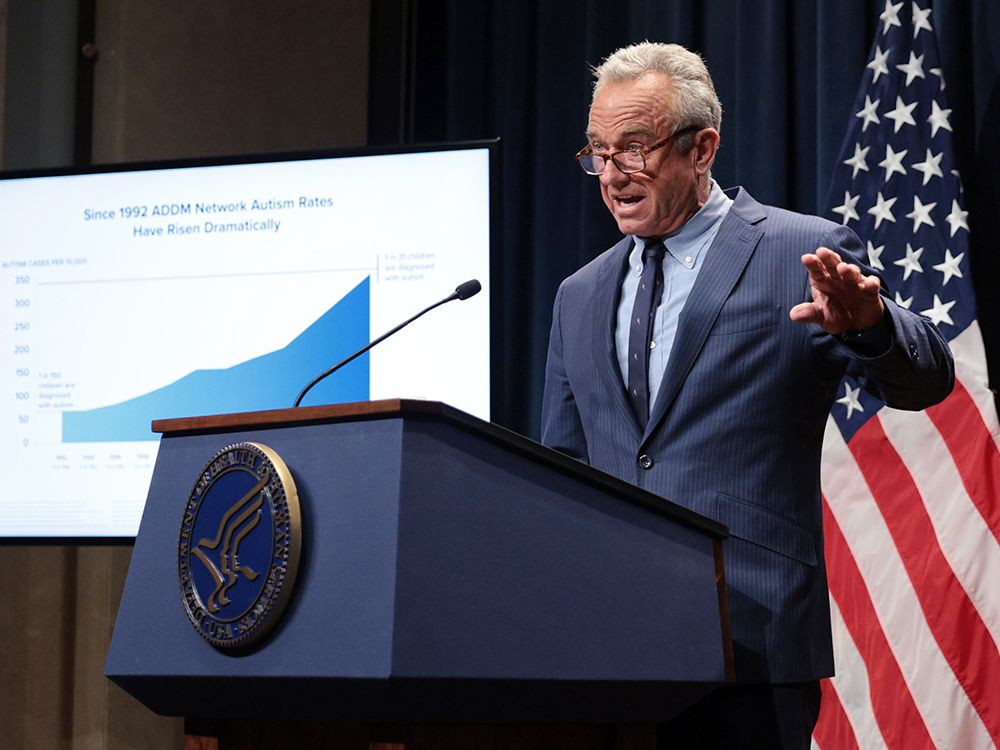Robert F. Kennedy Jr., America’s top health official under U.S. President Donald Trump, has vowed to solve what he calls an “autism epidemic,” but the rising number of diagnoses is largely due to a loosening of what counts as autism, according to an eminent psychiatrist who led the task force that expanded the criteria 30 years ago.
Before then, classic autism “always presented itself by age three with incapacitating cognitive, interpersonal, emotional and behavioural symptoms,” Dr. Allen Frances, a professor emeritus and former chair of the department of psychiatry at Duke University in North Carolina, wrote in an email to National Post.
“Current ‘Autism Spectrum’ includes many very highly functioning people who are just socially awkward and a bit eccentric,” he said.
Frances is among leading scientists accusing Kennedy, the U.S. health and human services secretary, of pushing harmful conspiracy theories about the causes of autism.
In a recent series of news conferences, interviews and
Kennedy has, to the outrage of many in the autism community, portrayed children with autism as kids who “will never pay taxes, never hold a job” and has described autism as a “preventable disease” caused by one or more environmental toxins.
Kennedy has also accused “epidemic deniers” of buying into “this industry canard, this mythology” that rising rates of autism are due to better recognition and shifting diagnostic criteria. Most recently, he said families of those “injured” by environmental exposures should be compensated.
“Bottom line, the more than 25 per cent of people who have severe autism will never go on a date, write a poem, live independently, or have a job,” Kennedy said in a
, clarifying that, in earlier comments, he was speaking specifically about children with profound autism.
“We need to identify the exposures that are causing this epidemic and compensate the families of the injured.”
Kennedy has promised to come up with “some answers” behind rising reported rates of autism by September, walking back an earlier pledge that his agency will “know what has caused the autism epidemic” by fall.
In a
radio interview Easter Sunday,
Kennedy said autism “dwarfs the COVID epidemic and the impacts on our country because COVID killed old people.”
“Autism affects children and affects them at the beginning of their lives, the beginning of their productivity,” Kennedy said.
He accused American government scientists of “blocking all studies” into possible environmental triggers and said his agency will deploy 15 teams to look at possible exposures, such as mould, food additives, pesticides, vaccines and the age of the parents, as well as the most commonly prescribed anti-depressants, a class known as selective serotonin re-uptake inhibitors, or SSRIs.
In an earlier interview with
, Kennedy said the “non-verbal, non-toilet trained … head-banging, biting, toe walking” population of children with autism is growing “higher and higher. It’s become a larger percentage, so were seeing many more cases that are now linked to severe intellectual disabilities.”
However,
one study of more than 4,600 eight-year-olds
identified with autism spectrum disorder (ASD) in the New York-New Jersey metropolitan area between 2000 and 2016 reported a 500 per cent increase in the prevalence of kids with ASD without an intellectual disability over the study period, compared to a 200 per cent increase in kids with ASD with intellectual impairment.
Most children with autism spectrum disorder “have intellectual ability in the non-disabled range,” the team reported, a trend they said is likely explained by better recognition of autism among kids with average intellectual ability.
Kennedy “has spread dangerous lies about the causes of autism,” said Frances. “It has already been definitively proven that vaccines do not cause autism and it is not yet known whether environmental toxins play any role.
“His promotion of vaccine denial conspiracy theories is a great threat to public health.”
Autism is a neurodevelopmental condition impacting brain development. “The result is that most individuals experience communication problems, difficulty with social interactions and a tendency to repeat specific patterns of behaviour,”
Autism Canada’s website explains.
Autism can’t be cured. However, children, teens and adults with autism “vary widely in their needs, skills and abilities,” there’s no “typical” person with autism spectrum disorder and the objective is to increase people’s quality of life and happiness, the group said.
While researchers are still working to understand potential causes, autism is not contagious, not caused by vaccination and not caused by parenting style, according to the
Public Health Agency of Canada.
One long since abandoned, discredited and harmful theory blamed emotionally distant mothers for autism.
, one in 50, or two per cent of Canadian children and youth aged one to 17 were diagnosed with autism spectrum disorder. Rates varied widely, from 0.8 per cent in Saskatchewan to 4.1 per cent in New Brunswick.
Boys were diagnosed about four times more frequently than girls.
There’s no biological marker, like a blood test, to confirm autism. Rather, a diagnosis is based on whether a person fits criteria from the Diagnostic and Statistical Manual of Mental Disorders, or DSM, criteria that have changed with the manual’s evolution.
Autism was included for the first time in the DSM’s third edition, in 1980. Asperger’s syndrome, a much milder form of autism, was added in the fourth edition, DSM-IV, in 1994. Field trials then suggested merging Asperger with autism would increase the rate of autism three-fold. Instead, it increased 50-fold.
Frances led the DSM-IV task force. “My biggest DSM-IV regret: Our broadening the autism definition that has led to such massive, careless over-diagnosis,”
The fifth and current edition collapsed autism and Asperger’s further into a “spectrum” that merged other subtypes, such as childhood disintegrative disorder.
The
latest data from the U.S. Centers for Disease Control and Prevention
found about one in 31 U.S. children aged eight had been identified with autism in 2022 across 16 sites, up from one in 36 in 2020, and one in 150 in 2000, the year the agency began monitoring trends in diagnoses.
Like Canada, rates varied widely, but there is no evidence that living in certain communities puts children at greater risk for developing autism, the CDC said. The differences might be down to differences in the availability of services for early detections, evaluations and “diagnostic practices,” the agency said.
Kennedy “says things that uniformed people used to say about autism 25 year ago,” after an infamous and since retracted paper falsely linked the MMR (measles, mumps and rubella) vaccine with autism, said Dr. Laurent Mottron, a professor at the Université de Montréal’s department of psychiatry and an international leader in autism research.
Mottron has been called so often by American media lately that he’s prepared what he described as a “general fact sheet” about autism. “The most important error is the idea that autism has a cause,” Mottron said. “Because the most demonstrated neuroscience finding on autism over the last 20 years is the fact (people have) a familial predisposition,” meaning autism has a tendency to run in families, likely through genetics.
In identical twins that have exactly the same genes, about 30 per cent have “discordant” handedness, meaning one twin is right handed and the other a lefty. Their brains are organized differently, even with the same genetic background, Mottron said. In a similar way, “extremely subtle differences can result in somebody” developing autism, he said, differences that are “probably nearly random and not really with a cause.”
Mottron’s fact sheet also states the the “spectrum” criteria are “vague and trivial” —
found only 47 per cent of of 232 children and teens with a diagnosis of autism spectrum disorder met criteria for ASD after an extensive re-evaluation — some parents and schools may “push toward an autism diagnosis for services,” and, while it’s not clear why boys are diagnosed at a higher rate, “boys are more vulnerable to neurodevelopmental conditions.”
National Post
Our website is the place for the latest breaking news, exclusive scoops, longreads and provocative commentary. Please bookmark nationalpost.com and sign up for our newsletters here.






